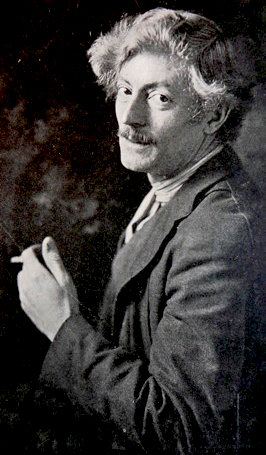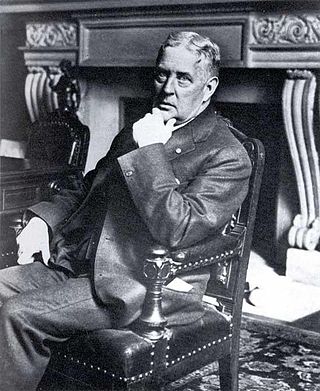
Emanuel Gottlieb Leutze was a German-American history painter best known for his 1851 painting Washington Crossing the Delaware. He is associated with the Düsseldorf school of painting.

Kenneth Noland was an American painter. He was one of the best-known American color field painters, although in the 1950s he was thought of as an abstract expressionist and in the early 1960s he was thought of as a minimalist painter. Noland helped establish the Washington Color School movement. In 1977, he was honored by a major retrospective at the Solomon R. Guggenheim Museum in New York that then traveled to the Hirshhorn Museum and Sculpture Garden in Washington, D.C. and Ohio's Toledo Museum of Art in 1978. In 2006, Noland's Stripe Paintings were exhibited at the Tate in London.

Thetford is a town in Orange County, Vermont, United States in the Connecticut River Valley. The population was 2,775 at the 2020 census. Villages within the town include East Thetford, North Thetford, Thetford Hill, Thetford Center, Rices Mills, Union Village, and Post Mills. The town office is in Thetford Center.
Milton Clark Avery was an American modern painter. Born in Altmar, New York, he moved to Connecticut in 1898 and later to New York City. He was the husband of artist Sally Michel Avery and the father of artist March Avery.

Gilbert Charles Stuart was an American painter from Rhode Island Colony who is widely considered one of America's foremost portraitists. His best-known work is an unfinished portrait of George Washington, begun in 1796, which is sometimes referred to as the Athenaeum Portrait. Stuart retained the portrait and used it to paint scores of copies that were commissioned by patrons in America and abroad. The image of George Washington featured in the painting has appeared on the United States one-dollar bill for more than a century and on various postage stamps of the 19th century and early 20th century.

The Hudson River School was a mid-19th-century American art movement embodied by a group of landscape painters whose aesthetic vision was influenced by Romanticism. The paintings typically depict the Hudson River Valley and the surrounding area, including the Catskill, Adirondack, and White Mountains.

Thomas Cole was an English-born American artist and the founder of the Hudson River School art movement. Cole is widely regarded as the first significant American landscape painter. He was known for his romantic landscape and history paintings. Influenced by European painters, but with a strong American sensibility, he was prolific throughout his career and worked primarily with oil on canvas. His paintings are typically allegoric and often depict small figures or structures set against moody and evocative natural landscapes. They are usually escapist, framing the New World as a natural eden contrasting with the smog-filled cityscapes of Industrial Revolution-era Britain, in which he grew up. His works, often seen as conservative, criticize the contemporary trends of industrialism, urbanism, and westward expansion.

Thomas Hopkins Gallaudet was an American educator. Along with Laurent Clerc and Mason Cogswell, he co-founded the first permanent institution for the education of the deaf in North America, and he became its first principal. When opened on April 15, 1817, it was called the "Connecticut Asylum for the Education and Instruction of Deaf and Dumb Persons," but it is now known as the American School for the Deaf.

Edward Miner Gallaudet, was the first president of Gallaudet University in Washington, D.C. from 1864 to 1910.

William Morris Hunt was an American painter.

John Quincy Adams Ward was an American sculptor, whose most familiar work is his larger than life-size standing statue of George Washington on the steps of Federal Hall National Memorial in New York City.
William Cruikshank was a British painter and the grand-nephew of George Cruikshank. He studied art at the Royal Scottish Academy in Edinburgh, at the Royal Academy School in London with Frederic Leighton and John Everett Millais, and in Paris at the Atelier Yvon. His last studies were interrupted by the Franco-Prussian War.

Jared Bradley Flagg was an American painter.

Edson Fessenden Gallaudet was a pioneer in the field of aviation. He was best known for his development of practical airfoils and aircraft propulsion systems for use in early seaplanes.

Thetford Academy is a coeducational independent school in Thetford, Vermont. Located at 304 Academy Road in Thetford Center, Vermont, it is the state's oldest secondary school. Thetford Academy celebrated its bicentennial year in 2018–2019.

Gottlieb Daniel Paul Weber was a German artist. Weber is known for his ethereal and timeless landscape paintings of early northeast America. He emigrated to the U.S. in 1848 and though he returned to Germany around 1860 his influence on American landscape painting was still felt for years.

Dawson Dawson-Watson (1864–1939) was a British-born Impressionist painter who became famous in 1927 for winning the largest cash prize in American art, the Texas Wildflower Competitive Exhibition. He was one of the first members of the famous Impressionist colony in Giverny, France and was a prominent teacher in Hartford, Connecticut, St. Louis, Missouri and San Antonio, Texas.

Edmund Charles Tarbell was an American Impressionist painter. A member of the Ten American Painters, his work hangs in the Boston Museum of Fine Arts, Metropolitan Museum of Art, National Gallery of Art, Smithsonian American Art Museum, Corcoran Gallery of Art, DeYoung Museum, National Academy Museum and School, New Britain Museum of American Art, Worcester Art Museum, and numerous other collections. He was a leading member of a group of painters which came to be known as the Boston School.

Samuel Burtis Baker, commonly known as Burt Baker, was an American artist and teacher, best known for his portrait paintings.

Frederick J. Bacon (1871-1948) was a late 19th to mid 20th century performer and recording artist on the five string banjo. He was also an inventor and entrepreneur, educator, composer, and designer and manufacturer of banjos. At the height of his performance career he played the banjo nationally. Along with Fred Van Eps and Vess Ossman he was part of a group of banjoists labeled "virtuoso" in the newspapers. He founded the F.J Bacon Co., possibly as early as 1902, after having invented a new resonator for open-back banjos. It wasn’t until 1908 that Bacon came up with Bacon Mfg. & Publishing Co. to sell his banjos and music compositions. During the Big Five tour Bacon became Bacon Mfg. Co in 1911 from Forestdale and incorporated Bacon Mfg. Co. in 1912. In 1918 from New London he called himself Bacon Banjo Mfg. Co. around 1918, and formally the Bacon Banjo Co. Inc in 1920 with E.O Winship and wives. In 1922 his company gained business experience in David L. Day, formerly of Vega. Together they produced Bacon and Day banjos, some of which have been considered worthy of display in museums, as showpieces of artistic impulse from the Jazz Age. Frederick and his wife Cassie were proponents of the classic banjo style of playing banjo, in which the strings are plucked with the fingers, without picks.


















